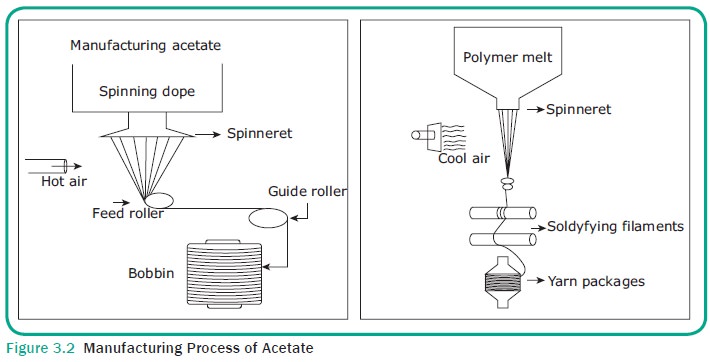Types, Manufacturing Process, Finishing Process, Properties, Uses| Man-Made Fibres - Acetate fibre | 11th Textiles and Dress Designing : Chapter 3 : Man-Made Fibres
Chapter: 11th Textiles and Dress Designing : Chapter 3 : Man-Made Fibres
Acetate fibre
ACETATE
Acetate fibres are chemical compounds of
cellulose and not the pure cellulose as in rayon fibres. These chemical
com-pounds have their own unique properties and in fact the various types of
cellulose acetate fibres differ from each other in properties. In 1865, Pant
Schutzenberger discovered the reaction of cellulose ace-tate. Later in 1903,
the German chem-ists Arthur Eiechengeun and Theodore Becker invented the fast
soluble form of cellulose acetate.
In 1904, cellulose acetate was developed by
Camille Dreyfus and his younger brother Henri in England, during World War I.
It was used as a non flam-mable lacquer for the fabrics used for cov-ering the
wings and fuselage of aircrafts. In 1918, they perfected the technique of
spinning this substance into lustrous fil-aments of “artificial silk”.
Subsequently, British Celanese Ltd. started the produc-tion of this fibre. In
1924, the commercial production of acetate fabric started in the United States
by Celanese Corp. In 1954, The Celanese Corp. of America undertook the
production of a variation of this chem-ical called cellulose triacetate. This
prod-uct is marketed by the Celanese Fibres Marketing Co. under the trademark
Arnel.
Types of Acetate
The different types of acetate are
1.
Diacetate
2.
Triacetate.
Manufacturing Process of Acetate
Pure cellulose is formed by converting cotton
linters or wood sheets. This pure cellulose is steeped in glacial acetic acid
and aged under controlled temperature for a period of time. It is then mixed
with acetic anhydride and a small amount of sulphuric acid as a catalyst to
facilitate the reaction which produces a thick and clear liquid solution of
cellulose acetate. This liquid is then passed through the spin-neret to form
these fibres which is solidi-fied and rolled on the bobbins for later use
(Figure 3.2).

Properties of Acetate and Triacetate
Shape :
Can be
modified as per requirement
Size : Thin
long filament
Luster : Variation from brightness to
dullness
Strength
: Good
Elongation
: Good up
to 25%
Elastic
recovery : Good
Resiliency
: Low for
acetate, but for triacetate it is good.
Dimensional
stability: Good
Resistance
to acids : Fair resistance to dilute acid, but cannot
withstand concentrated acid.
Resistance
to alkalis : Good resistance to dilute alkalis but cannot
withstand concentrated alkalis.
Resistance
to flame : Burns easily
Finishing Process
Depending upon the kind of yarns used and the
final effect desired, different fin-ishes can be given to acetate fabrics. The
most common finishes are :
Embossing
: For
pattern or design
Heat
setting : For
crease and shape retention
Moireing
: For
permanent watermarking effect
Napping
: On spun
acetate for softness and warmth
Sizing
: For
better appearance
Water
repellency : For resistance to water and rain
Wrinkle
resistance : For better shape retention
Uses of Acetate
The uses of acetate are :
·
The breathable nature of the fabric makes it
suitable for use as a lining fabric for apparels.
·
Acetate is used for making cigarette filters and
other filters, ink reser-voirs for fibre tip pens.
·
It is used for making high absor-bency products
like diapers and sur-gical products.
·
It is also used for making eyeglass frames.
Related Topics